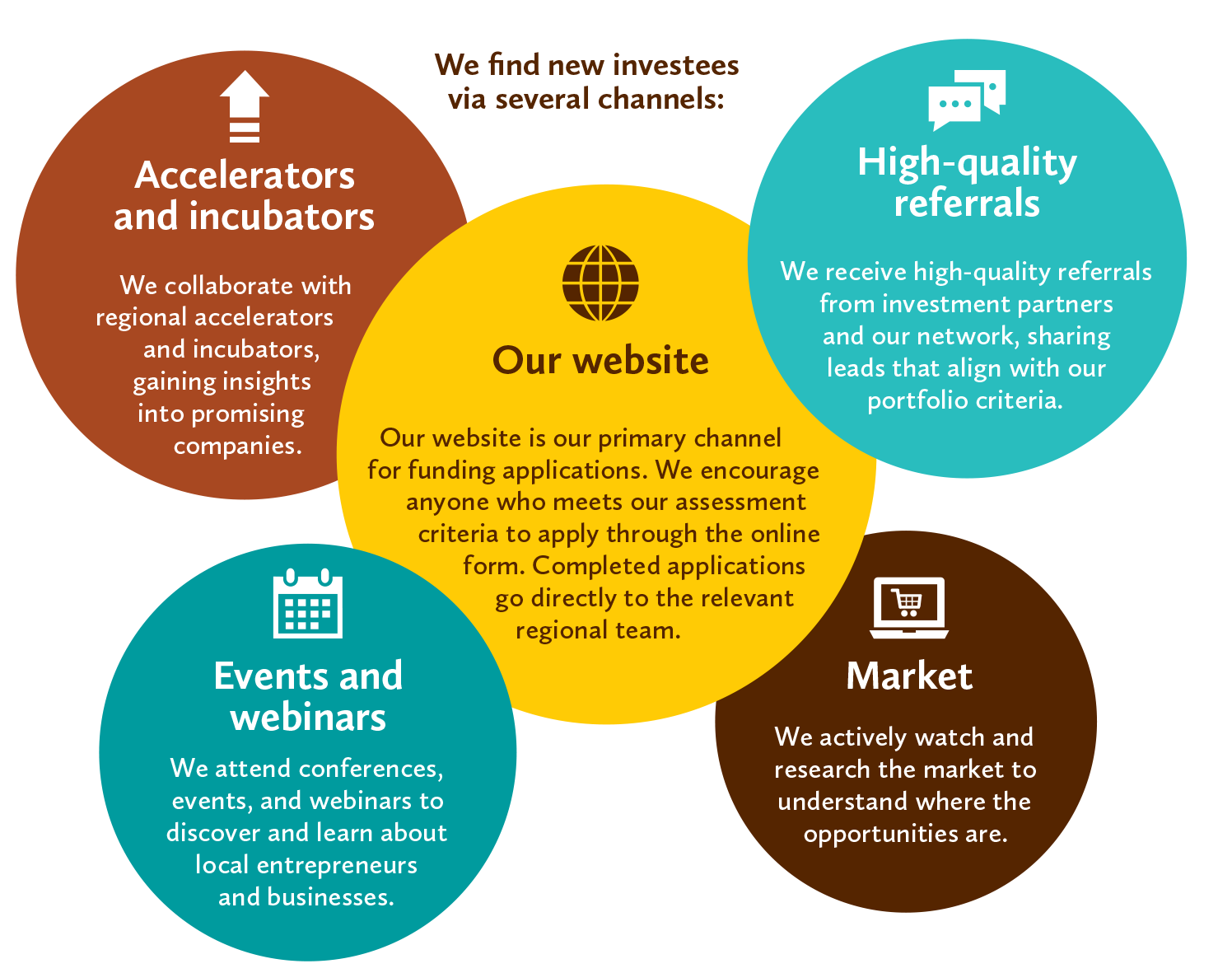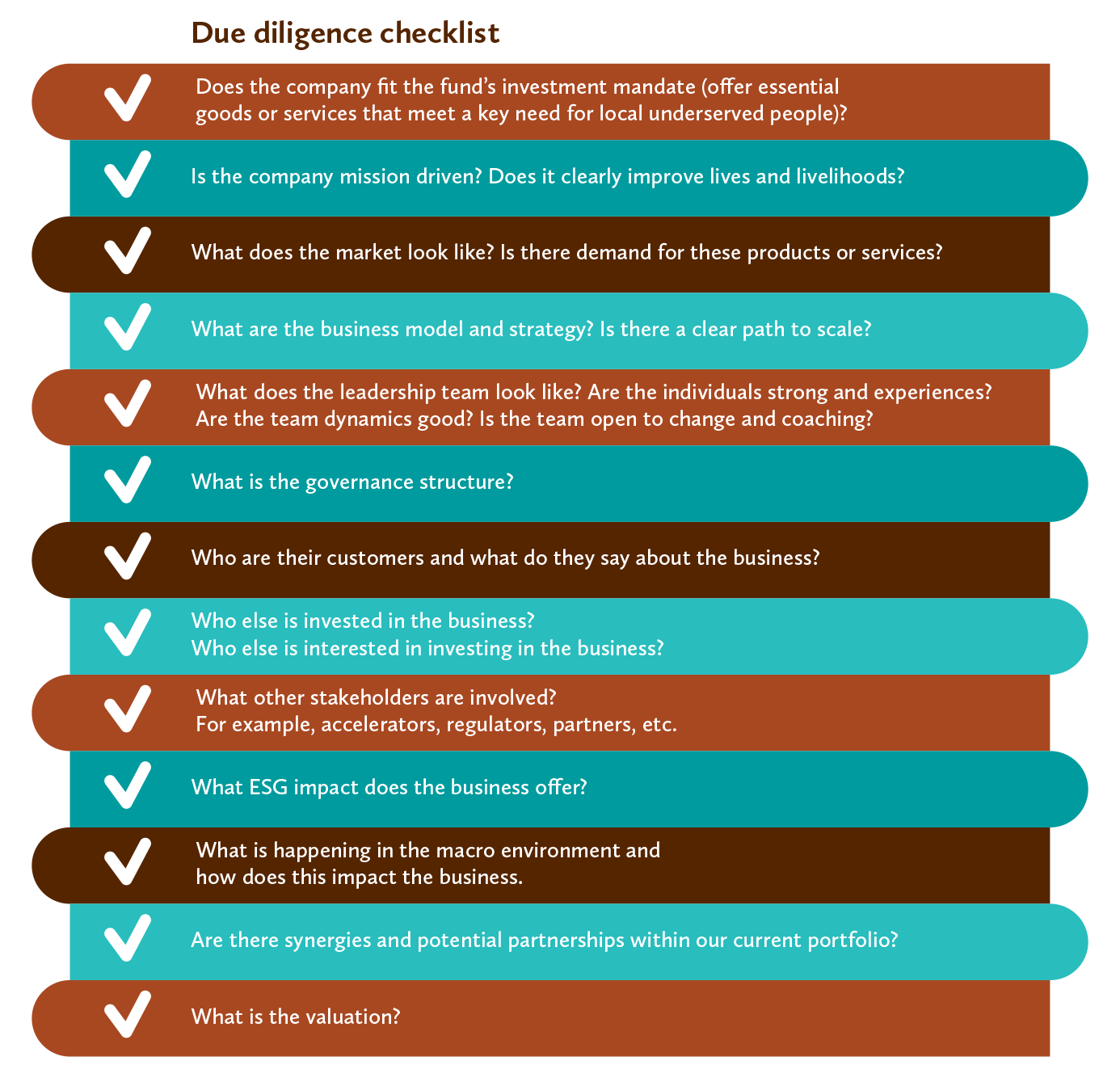
Understanding our investment process
Jade Buckton, Investment Associate at Goodwell, explains how we find, assess and support our portfolio companies.
At Goodwell Investments, we’re extremely passionate about investing in organisations that improve the wellbeing of the people and communities they operate within. We believe that doing good business, is good business. Especially in Africa where inclusive businesses that provide essential products are highly resilient and able to grow, despite macroeconomic challenges.
Our investment philosophy – to invest in early-stage (often tech-enabled) local organisations that are able to deliver high-impact essential goods and services – has stood us in good stead so far. Our flagship social impact fund, the uMunthu I fund, raised €62.6 million and invested in 20 high-impact portfolio companies in sub-Saharan Africa.
Following this success and the continued demand for social impact investment opportunities, we recently launched uMunthu II. Through it we’re currently raising €150million to continue our mission of empowering high-impact organisations in sub-Saharan Africa to reach their full potential and igniting the growth of inclusive businesses across Africa.
Goodwell’s Investment process: due diligence and beyond
Funding is only one of the ways that Goodwell supports its portfolio companies. We also offer valuable help along the way, from networking, to setting up the correct structures and governance, all the way to ensuring ESG reporting is in place as the organisation grows.
Given this high-touch way of working with each of our portfolio companies, we take a very thorough approach to assessing potential investees, selecting only those that align with our investment strategy and have a strong chance of success.
To help you understand how we identify, assess, and support our portfolio companies, we invited Jade Buckton, Investment Associate here at Goodwell Investments, to answer some frequently asked questions. Jade oversees pipeline sourcing, deal flow, and deal origination for our funds across various regions. Additionally, she plays a key role in creating investment strategies for uMunthu II, focusing on identifying and exploring new impact sectors for potential investment opportunities.
Q: How do you identify new funding opportunities?
New funding opportunities come to us through a variety of channels. This graphic provides an overview of the most important ways we find potential investees.

Q: How many funding applications do you receive?
A lot! We receive 100-200 online applications per month. About a quarter of these meet our investment mandate. We process these applications by assessing the viability and potential impact of each business.
Q: How do you assess funding applications?
We start by investigating whether the business fits our investment mandate. If they do, then we start our due diligence process, and if all goes well, once we have final approvals from our investment committees, we can onboard the company within 4-8 weeks.
Our due diligence process has two phases. The first is an internal process. This is where the regional investment team conducts high-level research and presents the opportunity to Goodwell’s investment committee. During this phase, we work through our due diligence checklist – conducting our own research, visiting the business, and interviewing the company’s leadership team and other key stakeholders – to answer the following questions:

Our ESG Analyst, Oracle Ningiza, also gets involved at this stage. He helps us to understand and assess the company’s ESG opportunities, as well as what needs to be done to achieve impact.
If we determine that this opportunity meets our criteria, we proceed to draft an investment memo for presentation to the Internal IC. Upon approval at this stage, we advance to presenting it to the external IC. If endorsed by the external IC, we then transition to the second phase of due diligence. This is where we bring in external legal and financial experts to assess risk and help us mitigate it.
We incorporate their feedback and advice into our deal agreements to mitigate the risk. Or, if we find that the risks are too high, we support the company in overcoming these challenges (for example by helping them to obtain a licence).
Q. If the opportunity looks promising, what is the next step?
If we’re satisfied that after all the DD processes this is a good opportunity (in terms of both financial return and social impact), we’ll make an investment offer and begin contracting. Sometimes, we work with other investors to pool funds. We like to be an early mover, so we’re open to taking a bit of risk if it helps convince other investors to get involved.
Q. What do you focus on once you have invested in the company?
One of our foremost priorities is to ensure that the company has robust governance structures in place. If they lack such structures, we assist in establishing a board of directors and implementing sound governance practices. This foundational step ensures that the company has a solid framework for decision-making and accountability, laying the groundwork for their sustainable growth and success.
We also collaborate with early-stage companies to initiate the process of measuring and reporting their impact. This can be particularly challenging for very early-stage firms, as they typically lack in-house resources dedicated to impact measurement. When we identify genuine potential for creating positive change, our approach involves initially prioritising their path to profitability. Once they have achieved this milestone, we then assist them in integrating ESG metrics into their reporting. This phase often coincides with their ability to expand their team and bring an ESG/Sustainability Officer on board.
Q. How do you measure social impact?
We measure social impact by defining specific impact metrics, collecting and analysing relevant data, and requiring regular impact reports from our portfolio companies. We may also engage third-party verification when necessary, and continuously monitor and provide support to enhance impact measurement practices. Long-term impact assessment and alignment with ESG reporting standards further strengthen our approach, allowing us to effectively track and evaluate the social impact of our investments.
Q. What if the company doesn’t have clear ESG reporting in place?
If a company requires assistance in this area, we collaborate with them to create a 100-day action plan. This plan helps pinpoint the ESG metrics to monitor, designates responsibility for their oversight, and outlines the implementation process. In instances where a company lacks the capacity to establish ESG reporting, our investment managers and ESG team step in to provide guidance, aiding in the identification of impactful metrics and facilitating reporting.
Q. How are you working to standardise ESG reporting?
We have developed and implemented a set of clear, comprehensive guidelines for ESG reporting that all our portfolio companies are expected to follow. These guidelines outline the key ESG metrics, reporting frequency, and data collection methods. Within these guidelines, we reference global standards, including the Global Reporting Initiative, IRIS+ by the Global Impact Investing Network, and the 2X Criteria. These esteemed organizations assist us in delineating specific impact metrics tailored to each company and sector. The impact metrics we track are thoughtfully aligned with the United Nations Sustainable Development Goals, ensuring a holistic approach to measuring and reporting our investments’ social impact
Learn more about our approach to investing
If you have any questions that Jade didn’t cover in this piece, please let us know. We’d be happy to help you find the answer. You can get in touch with us at contact@goodwell.nl
To delve deeper into the world of investing with Goodwell, your journey continues on our dedicated investor page.
Those looking to explore funding opportunities are invited to visit our funding application page. We’re eager to hear more about your specific needs and objectives.